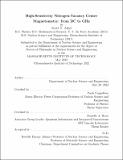High-Sensitivity Nitrogen-Vacancy Center Magnetometry: from DC to GHz
Author(s)
Alsid, Scott T.
DownloadThesis PDF (18.75Mb)
Advisor
Cappellaro, Paola
Terms of use
Metadata
Show full item recordAbstract
In the past 15 years, quantum sensing of magnetic fields using nitrogen-vacancy (NV) center ensembles in diamond has matured into an established discipline, with several proof of principle demonstrations in condensed matter physics, biological systems, electronics testing, and geomagnetism. However, despite the prospect of comparable magnetic field sensitivity, the performance of NV bulk magnetometers sensing low-frequency fields continues to lag behind that of their atomic vapor cell and superconducting counterparts by about three orders of magnitude. Detecting GHz-frequency fields compares much worse, with an additional three order of magnitude reduction in demonstrated sensitivity.
This thesis presents two experimental thrusts designed to improve an NV-ensemble magnetometer by optimizing diamond processing and sensor construction. We first investigate the irradiation and annealing process of diamond samples by developing an NV-charge state spectral decomposition technique, which we use to examine the creation dynamics and diffusion of monovacancies in the diamond lattice. We also examine the behavior of the spin coherence timescales under increasing electron irradiation doses. We then construct an NV-ensemble magnetometer by implementing and expanding upon the best techniques used for diamond growth, microwave delivery, optical excitation and readout, and pulse-control sequences. We use this sensor to demonstrate the most sensitive NV-based bulk magnetometer reported to date in both broadband and narrowband operation, sensing fields in the kHz and GHz frequency range. These experimental efforts demonstrate a deeper understanding and improvement in NV-ensemble magnetometry, opening up new application spaces in several frequency bands of interest.
Date issued
2022-05Department
Massachusetts Institute of Technology. Department of Nuclear Science and EngineeringPublisher
Massachusetts Institute of Technology